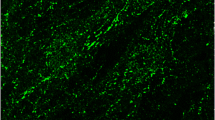Summary
Cerebral neurones, with their intricately branching processes, have the highest surface/volume ratio of all cells. When cerebral grey matter disintegrates, the uniquely extensive surface of these ramifying cells becomes disorganised. Hydrophobic lipid remnants derived from this vast expanse of lipoprotein membranes may thus account for the highly characteristic PAS-positive granules found in phagocytes present in zones of softening produced by ischaemic necrosis of the cerebral cortex.
This view was supported by further observations on these granules in phagocytes of necrotic cerebral cortex and also by the presence of granules with the same cytochemical properties in similar phagocytes which were found in necrotic cerebellar cortex. In the latter tissue, in which the neurones also possess an exceptionally large surface area owing to the extent of their axo-dendritic arborisations, neuronal disintegration was also followed by the appearance of apparently identical intraphagocytic deposits.
The granular material within phagocytes of necrotic grey matter of both cerebral and cerebellar cortex was intensely coloured by Sudan black B, PAS, and paraldehyde fuchsin after pre-treatment with KMnO4. The colouration by PAS was not inhibited by previous incubation with amylase nor by previous bromination, but was suppressed after acetylation. Although faint brown in colour the granules did not contain ferric iron.
The granular histiocytes found in necrotic grey matter differed from the foamy histiocytes seen in disintegrating white matter during the destruction of myelin.
The granular material in the phagocytes of softened grey matter may be a hydrophobic coacervate formed by disarray of orientated lipoproteins and gangliosides during the disintegration of the extensive surfaces of axo-dendridic arborisations.
Similar content being viewed by others
References
Carleton, H. M.: Histological technique, p. 145. London: Oxford University Press 1957
Deny, G., Lhermitte, J.: Un nouveau syndrome anatomo-clinique: la démence paraplégique de l'encéphalite cortical chronique. Sem. méd. (Paris)30, 585–588 (1910)
Dixon, K. C.: Cytochemical changes in necrotic grey matter of the brain. J. Path. Bact.66, 251–262 (1953)
Dixon, K. C.: Cytochemistry of a cerebral scar. J. Path. Bact.68, 85–88 (1954)
Dixon, K. C.: Cytochemistry of the cortical ground substances in apoplexy. J. Path. Bact.69, 251–257 (1955)
Dixon, K. C.: Neuronal protein. In: Proc. IInd Internat. Cong. Neuropath., pp. 55–59. Amsterdam: Exerpta Medical Foundation 1956a
Dixon, K. C.: Persistence of protein in infarcts. J. Path. Bact.71, 37–43 (1956b)
Dixon, K. C.: Ischaemia and the neurone. In: C. W. M. Adams: Neurohistochemistry, pp. 558–598. Amsterdam-London-New York: Elsevier Publ. Co. 1965
Dixon, K. C.: Events in dying cells. Proc. roy. Soc. Med.60, 271–276 (1967a)
Dixon, K. C.: Cerebral vulnerability to ischaemia. Lancet1967 II, 289–290
Dixon, K. C.: Hydrophobic lipids in injured cells. Histochem. J.2, 151–187 (1970)
Greenfield, J. G.: The retina in cerebral lipidosis. Proc. roy. Soc. Med.44, 686–689 (1951)
Lehninger, A. L.: The neuronal membrane. Proc. nat. Acad. Sci. (Wash.)60, 1069–1080 (1968)
McManus, J. F. A.: Histological and histochemical uses of periodic acid. Stain Technol.23, 99–108 (1948)
McManus, J. F. A., Cason, J. E.: Carbohydrate histochemistry studied by acetylation techniques. I. Periodic acid methods. J. exp. Med.91, 651–654 (1950)
Marinesco, G.: La cellule nerveuse. Vol. 2, p. 529. Paris: Octave Doin et Fils 1909
Pearse, A. G. E.: Histochemistry, theoretical and applied. Vol. I, p. 687, 3rd Ed. London: J. & A. Churchill Ltd. 1968
Petrescu, A.: Contributions histochemiques à l'étude des lipides dans les lésions demyélisantes. Ann. Histochem.11, 237–252 (1956)
Petrescu, A.: The histochemistry of demyelination with special reference to sudanophilic disintegration of myelin lipids. In: Reports of IInd National Symposium of Neuropathology, pp. 139–151. Bucuresti: Interprinderea Poligrafica 1968
Petrescu, A.: Histochemical identification of two kinds of lipomacrophages in demyelinating lesions of sudanophil type. Their essential role in myelin disintegration. Rev. roum. Neurol.6, 165–168 (1969)
Rambourg, A.: Morphological and histochemical aspects of glycoproteins at the surface of animal cells. In: International Review of Cytology, G. H. Bourne, J. F. Danielli, and K. W. Jeon, Eds., Vol. 31, pp. 57–114. New York-London: Academic Press 1971
Rambourg, A., Neutra, A. A., Leblond, C. P.: Presence of a “cell-coat” rich in carbohydrate at the surface of cells in the rat. Anat. Rec.154, 41–71 (1966)
Ramon y Cajal, S.: Les nouvelles idées sur la structure du système nerveux chez l'homme et chez les vertébrés, pp. 30–34. Paris: C. Reinwalt et Cie. 1894
Sagel, W.: Zur histologischen Analyse des Gliastrauchwerkes der Kleinhirnrinde. Z. ges. Neurol. Psychiat.71, 278–302 (1921)
Scott, H. R., Clayton, B. P.: A comparison of the staining affinities of aldehyde-fuchsin and the Schiff reagent. J. Histochem. Cytochem.1, 336–352 (1953)
Spielmeyer, W.: Histopathologie des Nervensystems, pp. 293–295. Berlin: Springer 1922
Wolman, M.: Study of the effects of hyperoxia on the central nervous system. J. P. Schadé and W. H. McMenemy, Eds., pp. 349–356. Oxford: Blackwell 1963
Wolman, M.: Structure of biological membranes: the lamellar versus the globoid concept. In: Recent progress in surface science, Vol. III, pp. 261–271. New York: Academic Press Inc. 1970
Wolman, M., Bubis, J. J., Wiener, H.: Histochemical study of the asymmetry of cell membranes. Histochemie9, 1–12 (1967)
Author information
Authors and Affiliations
Rights and permissions
About this article
Cite this article
Dixon, K.C., Gresham, G.A. Remnants of necrotic grey matter. Acta Neuropathol 28, 55–68 (1974). https://doi.org/10.1007/BF00687518
Received:
Accepted:
Issue Date:
DOI: https://doi.org/10.1007/BF00687518



